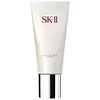What's inside
What's inside
 Key Ingredients
Key Ingredients

 Benefits
Benefits

 Concerns
Concerns

 Ingredients Side-by-side
Ingredients Side-by-side

Water
Skin ConditioningGlycerin
HumectantPotassium Palmitate
EmulsifyingSodium Stearate
CleansingPalmitic Acid
EmollientSodium Methyl Cocoyl Taurate
CleansingPotassium Laurate
EmulsifyingPolyethylene
AbrasivePotassium Stearate
CleansingLauric Acid
CleansingPotassium Myristate
EmulsifyingStearic Acid
CleansingMyristic Acid
CleansingPEG-3 Distearate
EmulsifyingGlycyrrhiza Glabra Root Extract
BleachingHydrolyzed Conchiolin Protein
Skin ConditioningSodium Laureth Sulfate
CleansingSodium Lauroyl Lactylate
EmulsifyingCaprylic/Capric Triglyceride
MaskingPotassium Sorbate
PreservativeButylene Glycol
HumectantLauryl Glucoside
CleansingSodium Cocoyl Isethionate
CleansingParfum
MaskingPolyquaternium-7
Tetrasodium EDTA
Benzoic Acid
MaskingSodium Benzoate
MaskingWater, Glycerin, Potassium Palmitate, Sodium Stearate, Palmitic Acid, Sodium Methyl Cocoyl Taurate, Potassium Laurate, Polyethylene, Potassium Stearate, Lauric Acid, Potassium Myristate, Stearic Acid, Myristic Acid, PEG-3 Distearate, Glycyrrhiza Glabra Root Extract, Hydrolyzed Conchiolin Protein, Sodium Laureth Sulfate, Sodium Lauroyl Lactylate, Caprylic/Capric Triglyceride, Potassium Sorbate, Butylene Glycol, Lauryl Glucoside, Sodium Cocoyl Isethionate, Parfum, Polyquaternium-7, Tetrasodium EDTA, Benzoic Acid, Sodium Benzoate
Water
Skin ConditioningGalactomyces Ferment Filtrate
HumectantButylene Glycol
HumectantPolysorbate 20
EmulsifyingGlycerin
HumectantSodium Hyaluronate
HumectantPEG-150
HumectantCellulose Gum
Emulsion StabilisingDisodium EDTA
Citric Acid
BufferingSalicylic Acid
MaskingLactic Acid
BufferingMalic Acid
BufferingSodium Citrate
BufferingSodium Benzoate
MaskingMethylparaben
PreservativeIllite Extract
Skin Conditioning
 Reviews
Reviews

Ingredients Explained
These ingredients are found in both products.
Ingredients higher up in an ingredient list are typically present in a larger amount.
Butylene Glycol (or BG) is used within cosmetic products for a few different reasons:
Overall, Butylene Glycol is a safe and well-rounded ingredient that works well with other ingredients.
Though this ingredient works well with most skin types, some people with sensitive skin may experience a reaction such as allergic rashes, closed comedones, or itchiness.
Learn more about Butylene GlycolGlycerin is already naturally found in your skin. It helps moisturize and protect your skin.
A study from 2016 found glycerin to be more effective as a humectant than AHAs and hyaluronic acid.
As a humectant, it helps the skin stay hydrated by pulling moisture to your skin. The low molecular weight of glycerin allows it to pull moisture into the deeper layers of your skin.
Hydrated skin improves your skin barrier; Your skin barrier helps protect against irritants and bacteria.
Glycerin has also been found to have antimicrobial and antiviral properties. Due to these properties, glycerin is often used in wound and burn treatments.
In cosmetics, glycerin is usually derived from plants such as soybean or palm. However, it can also be sourced from animals, such as tallow or animal fat.
This ingredient is organic, colorless, odorless, and non-toxic.
Glycerin is the name for this ingredient in American English. British English uses Glycerol/Glycerine.
Learn more about GlycerinSodium Benzoate is a preservative. It's used in both cosmetic and food products to inhibit the growth of mold and bacteria. It is typically produced synthetically.
Both the US FDA and EU Health Committee have approved the use of sodium benzoate. In the US, levels of 0.1% (of the total product) are allowed.
Sodium benzoate works as a preservative by inhibiting the growth of bacteria inside of cells. It prevents the cell from fermenting a type of sugar using an enzyme called phosphofructokinase.
It is the salt of benzoic acid. Foods containing sodium benzoate include soda, salad dressings, condiments, fruit juices, wines, and snack foods.
Studies for using ascorbic acid and sodium benzoate in cosmetics are lacking, especially in skincare routines with multiple steps.
We always recommend speaking with a professional, such as a dermatologist, if you have any concerns.
Learn more about Sodium BenzoateWater. It's the most common cosmetic ingredient of all. You'll usually see it at the top of ingredient lists, meaning that it makes up the largest part of the product.
So why is it so popular? Water most often acts as a solvent - this means that it helps dissolve other ingredients into the formulation.
You'll also recognize water as that liquid we all need to stay alive. If you see this, drink a glass of water. Stay hydrated!
Learn more about Water